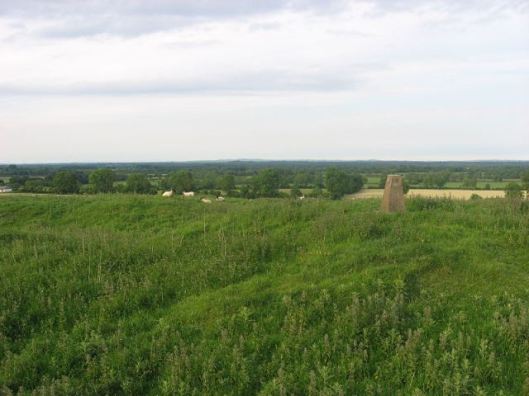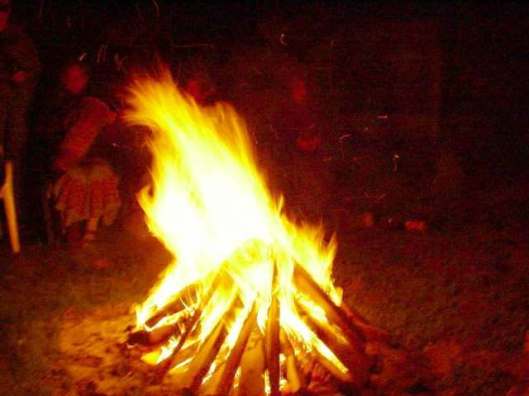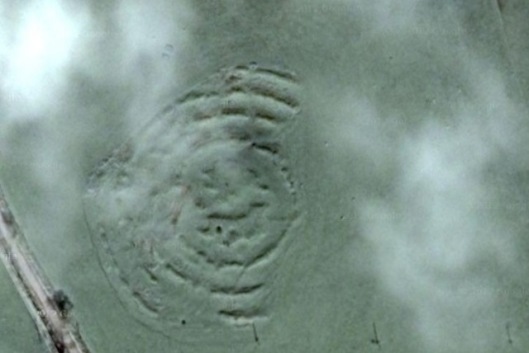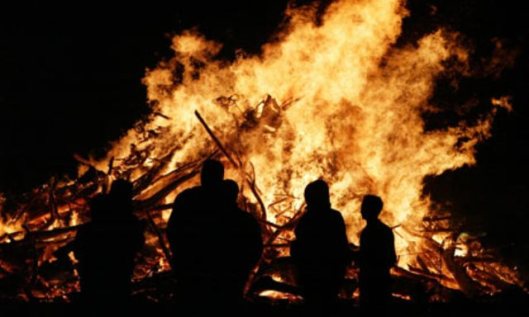As the big day approaces, I thought it might be nice to share with you the story of Tlacghta, considering its fascinating history and importance in the Samhain celebrations. So for those of you whom have not seen this before, please read on.
As previously mentioned the flame which re lit every fire across the country at Samhain came from Tlachtga. Tlachtga or the Hill of Ward as it is now known named after a former owner from the 17th century was once the spiritual center of Ireland. It was at Tlachtga that the Druids believed the gap between our world and the Other-world was at its thinnest. It can be found just outside Athboy in Co Meath and is approx 12 miles from the Hill of Tara. Tlachtga contains a hill fort consisting of four concentric banks with a central platform which is about 150 meters in diameter. It is said to have been disturbed in 1641 during Cromwell’s invasion but has to my knowledge never been properly excavated. However there have been suggestions that a barrow burial is contained within the hill, probably dating from the Bronze Age. The Hill took its name from a woman named Tlachtga whom died on the hill during child birth. There are two accounts of Tlachtga, one speaks of her as a Celtic Goddess, and the other refers to her as a powerful druidess. She was the daughter of the chief Druid and Teacher Mug Ruith. Mug Ruith is said to have been a well-seasoned traveler whom moved around the world in search of knowledge. As the story goes, after many years of travel with her father learning his magical secrets, she was raped by the sons of her father’s mentor. After returning to Ireland she bore three sons and died. She is said to have been buried on the Hill.
Each Samhain the flame was taken from Tlachtga and brought to Tara probably by boat via the Boyne River. At Tara the fire was lit and a great feast was held by the Ard Rí or High King along with Rí Tuaithe (provincial kings) and Flatha (nobility). Following the symbolic nature of the fire ritual the feast symbolised the unity and stability of the people of Ireland at a time of growing darkness and uncertainty. From Tara every fire across the country would be relit with the new flame as a symbol of a new beginning and rebirth. With the eventual onslaught of the new religion in Ireland like many other traditions and beliefs Samhain was absorbed into the Christian calendar as a feast day to remember the ‘Holy Souls’. In so doing, the tradition of remembering ones ancestors at this time survived under the guise of the new religion. The remainder of Samhain traditions that did not fit into Christianity survived in a form corrupted by Christianity with claims of devil worship and other false evils. It was during the famine that an exodus of Irish brought the practise of what is now known as Halloween to America resulting in its inevitable commercialization. Thankfully though, all has not been lost as I get a chance to impart the original traditions to my children and share them with others via this blog.
On a final note, there is an interesting story associated with Samhain. It tells of a fire being lit on a nearby hill at Samhain by a Christian missionary known as St. Patrick. Patrick was well versed in the ancient customs and traditions of the Irish as he had spent part of his youth as a slave in Ireland. The lighting of this fire showed a clear contempt and disregard for the native custom, as all fires on the night were lit from the sacred flame at Tlachtga. The High King Laoghaire on seeing the flame dispatch his men to extinguish the fire and bring the culprit before him. Some say that the kings men were unable to put out the fire and brought Patrick in chains to Tara to answer for his crime. The other story tells that when Patrick entered Tara he challenged the Druids of Ireland to a series of challenges in which he defeated them. Either way Patrick made an impression on the King and whilst Laoghaire refused to convert to Christianity he did give Patrick free reign to roam his kingdom and convert those whom wished to follow the new religion.
Today, the old Celtic ceremony at Tlachtga has been revived with a local re-enactment of the celebration starting with a torchlit procession from the Fair Green in Athboy, Co. Meath to the top of the Hill of Tlachtga, at 7pm on October 31st each year. All around the country you will find Bonfires lit. Even though when young we knew little about the significance of what we were doing. All we knew was we had a mid term break from school and we got to light big fires, dress up as monsters and go around getting free food from people. As a child I remember spending the weeks leading up to Samhain scavaging for wood to build the best Bonfire. There was a sense of pride in all the kids envolved as the street with the largest fire on the night held the bragging rights until the following year. It was only much later that I became aware of the true meaning of the tradition.
For these and more of my images, why not visit my Website or join me on Facebook or Twitter.









Very interesting Ed! Particularly St Pat lighting a fire near Thachtga at Samain, I read he did that at Slane at Bealtaine, but not that he did it at Samhain as well. He was very provocative, wasnt he? Laoighre must have got quite fed up of him flouting his authority all the time. One of Patricks letters makes reference to his being kept in chains for 60 days… I wonder if this was Laoighre trying to teach him a lesson???
LikeLiked by 1 person
I think so Ali, it was said that he was brought before Laoighre in chains, but there are so many conflicting accounts, its quite hard to get the full picture.
Now if it was me, I would have sent his head back in a box to Rome, some might think it a bit heavy handed, but I feel realy strong about the damage that was done to our country and people as a result of people like Patrick.
But then its easy to say in hindsight, perhaps Laoighre saw it in a different light???
LikeLiked by 1 person
I dont think he really understood the threat, or even took the strange holy man seriously. Things would be very different if he had.
LikeLiked by 1 person
I would hope so, but whats done is done, thankfully we have a little thing in life called Karma. The new religion is dying off and the old ways are slowly returning.
Its the circle of life I guess.
LikeLiked by 1 person
Absolutely!
LikeLiked by 1 person
I’m really glad you are telling your own children the traditional beliefs. It shouldn’t be too difficult either to revive the Celtic ceremonies at Tlachtga and the Hill of Tara in a big way…….Ireland’s Olympic Flame!
LikeLiked by 1 person
Much appreciated, There are still some whom are continuing the Gaelic Traditions of our ancestors. I got to join in at Tlacghta and Tara a couple of years ago. Check out https://edmooneyphoto.wordpress.com/2013/11/06/dark-moon-samhain/
LikeLike
Yet another great story those of us who live elsewhere have never heard! Keep up the great work… and I am still waiting impatiently for the book! 🙂
LikeLiked by 1 person
Thanks Dan, its getting closer to reality, next year should see alot of work being done to achive this 🙂
LikeLike
Another great historical piece – I was really interested to learn about St. Patrick’s involvement. One question, though – how the heck do you pronounce Tlachtga?
LikeLiked by 1 person
Gla k ta, is about right 🙂
LikeLike
More great legends and traditions, and informatively illustrated too. Thanks, Ed. Enjoy your much-anticipated Halloween!
Best wishes, Pete.
LikeLiked by 1 person
Pingback: Tlachtga and the Sacred Flame | Little Slice of Bri
Very interesting Ed, your historical knowledge is incredible.
LikeLiked by 1 person
Thanks Cameron, Oíche Shamhna Shona Duit 🙂
LikeLike
I think the only thing to say to that is “Yeah, right!!” 😉
LikeLiked by 1 person
Gaelic greeting for Samhain, in english its basically happy Halloween 🙂
LikeLike
Like it!
It’s a braw bricht moonlicht nicht the nicht d’ya ken!
LikeLiked by 1 person
Exactly 🙂
LikeLike
I don’t know the story of Tlachtga at all! Thanks for posting this Ed. Uisneach I know about and since it’s in the same area I wonder if this type of story was a common one in Meath/West Meath.
LikeLiked by 1 person
Most certainly, I went out here about two years ago for samhain. It was a great night. I will repost it later tonight 👍
LikeLike
I’ll be waiting 🙂
LikeLiked by 1 person
Its up and ready to go 🙂 https://edmooneyphoto.wordpress.com/2015/10/31/dark-moon-samhain-2/
LikeLiked by 1 person
Reblogged this on Jane Dougherty Writes and commented:
More Samhain stuff from Ed Mooney. Beats pumpkins any day of the week 🙂
LikeLike
I love these stories and customs.
It’s a strange, wonderful and awful history isn’t it?- including the spread of Christianity. I had heard by an Irish historian that the chief druid had warned the king that if he was tolerant he would be sorry and the new religion would take over!
I think I will give you something for the history challenge about how the meeting of two worlds affected the Mayans soon. I wrote several posts on them. I agree Christianity was pretty brutal but sometimes we tend to romanticize things too. Most peoples and religions had brutal aspects such as human sacrifice etc. and whether pagan or christian both saw power struggles and betrayals within their own cultures I think. Greek writers and observers wrote about the immolation of people in baskets by the celts to ensure fertility of the land.
I’m glad that old peaceful customs and mystical ideas are kept alive and continue especially those that revere the earth. I’m an idealist I think. (what do you think of the new pope?)
anyway- I got carried away with my own blah blah blah here lol! ( open for discussion!!)
LikeLiked by 1 person
I would tend to agree, but the human sacrifice nonsence is just that, perhaps some cults did practise it but I do not believe it was the norm.
Mayan post would be fantastic. Ali recently shared some Aztec photos, so it would be deadly to see the other big pre Columbian race represented.
The Ars Ri was indeed warned that if Patrick’s fire was not put out the flame of Christianity would burn for thousands of years.
Nothing wrong with idealism in my brow, but that pope is a Jesuit ! Not a nice bunch of lads despite how he portrays himself in public👍
LikeLiked by 1 person